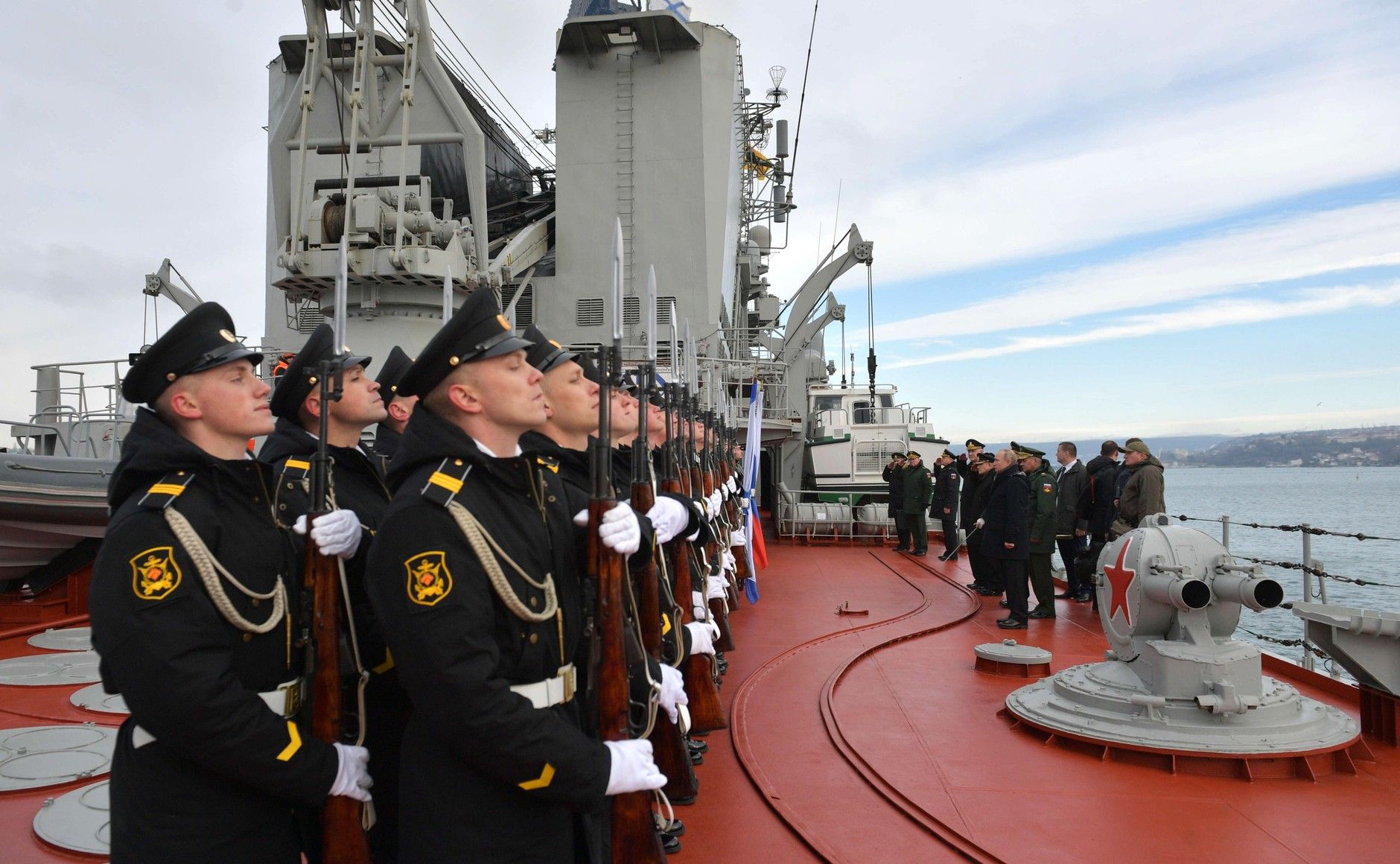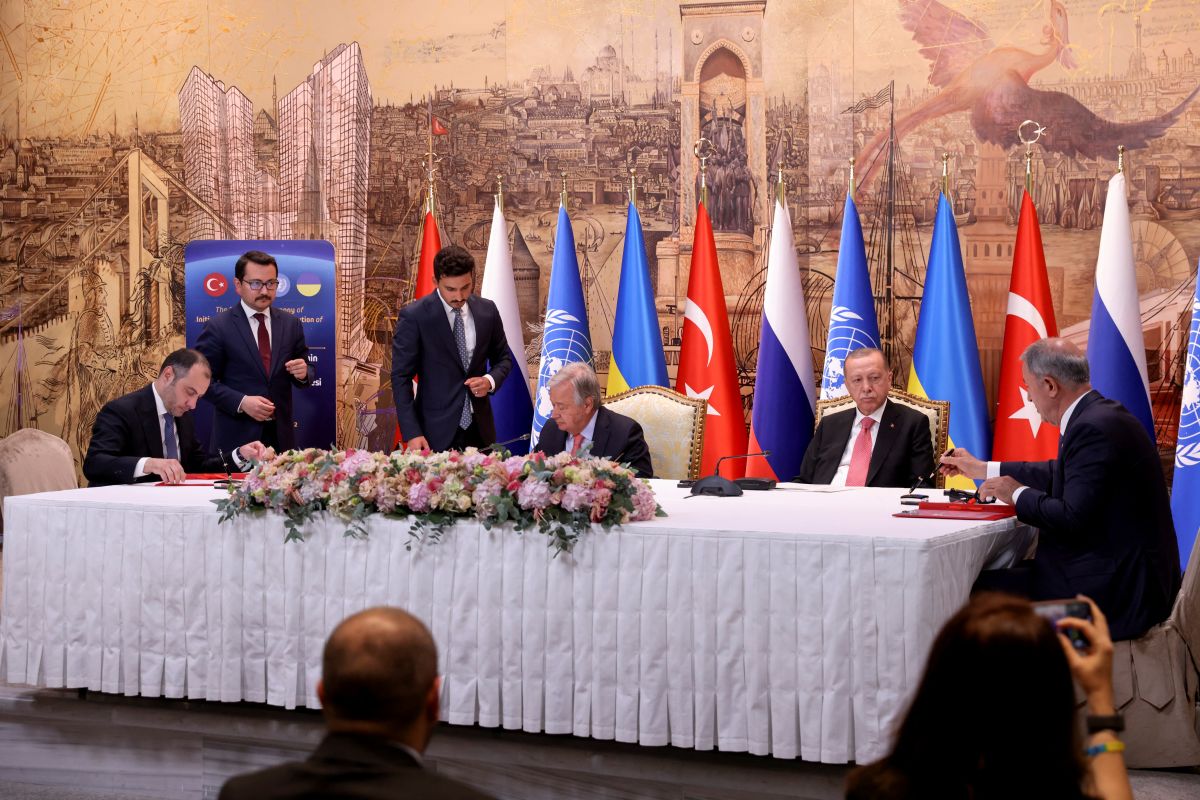How the War in Ukraine Impacts NATO Policy in the Black Sea Region
Russia’s invasion of Ukraine has increased the strategic importance of the Black Sea region for the security of NATO’s Eastern Flank. The activity of the Russian Black Sea Fleet, energy blackmail, and blocking of sea lines of communication pose a threat to the Alliance and its partner states (Moldova, Ukraine, Georgia). Although NATO’s ability to operate in the Black Sea is limited by the Montreux Convention, the Alliance can enhance deterrence credibility by increasing its military presence in the region and expanding cooperation with partners.
.jpg) STOYAN NENOV / Reuters / Forum
STOYAN NENOV / Reuters / Forum
The Black Sea states of the Alliance do not have a land border with Russia but are potentially vulnerable to military incidents and hybrid actions by Russia that threaten states providing support to Ukraine. Since the annexation of Crimea in 2014, Russia has significantly increased its military capabilities in the region. Control of the peninsula and the ability to conduct offensive operations is provided by the 30,000 or so troops stationed there along with 21 warships and numerous missile and air and missile-defence systems. The main task of the Black Sea Fleet is to control communication routes and conduct missile attacks against Ukrainian critical infrastructure. The confrontational nature of the Russian naval doctrine, adopted in August 2022, demonstrates the country’s readiness for provocative actions in the Black Sea basin, which it considers within its area of dominance. An example of this was the downing by a Russian fighter jet of a U.S. MQ-9 Reaper unmanned aircraft that was conducting a surveillance mission in international airspace. A similar incident occurred during a patrol flight by the Polish Border Guard carried out as part of the Frontex mission (JO MMO Black Sea). A Russian Su-35, without establishing radio contact, approached the Turbolet L-410 aircraft and then performed aggressive and dangerous manoeuvres that led to a temporary loss of control of the Polish patrol plane.
Vulnerability of the Region to Hybrid Threats
Alliance interests and security in the Black Sea region are also threatened by Russian hybrid actions. In June 2022, Russian warships appeared in the vicinity of the ANA offshore platform, which provides about 10% of Romania’s annual gas needs. Potential threats to offshore energy infrastructure include naval mines, unmanned aerial vehicles and autonomous underwater vehicles, cyberattacks, and the activity of sabotage groups. The explosion of the Nord Stream 1 and 2 pipelines in the Baltic Sea is a warning of similar threats in the Black Sea. Russia may seek to damage fibre-optic cables or energy infrastructure on the sea bottom to compound the economic impact of the war and influence NATO countries away from support for Ukraine.
Through hybrid methods, Russia is destabilising the internal situation in Moldova where it uses energy blackmail, disinformation, and financing of protests to undermine the pro-European Action and Solidarity Party (PAS) government and replace it with the pro-Russian Şor Party. The Moldovan authorities directly point to the activities of the Russian Federal Security Service (FSB) oriented towards staging a coup. Russia employs similar instruments of influence against Georgia (e.g., the embargo on imports of Georgian products, unfreezing of conflicts in Abkhazia and South Ossetia, and social polarisation in connection with the immigration of Russians). Russia’s strategic goal is to prevent the integration of Moldova and Georgia into the EU and to reintegrate these countries into the Russian sphere of influence.
A Change in NATO’s Approach to the Black Sea Region
Until Russia’s invasion of Ukraine, NATO assumed that the risk of an attack on member states in the Black Sea region was lower than in the Baltic region, thus the Alliance had more time to possibly strengthen its presence in the region. Therefore, within the framework of its tailored forward presence (tFP) initiative, slightly different collective defence mechanisms were developed there than in Poland and the Baltic States, where battalion battlegroups commanded by the U.S., Germany, Canada, and the UK were established. Although, a Multinational Division South-East (MND-SE) command was established in Romania to command Alliance forces on the southern section of the Eastern Flank, the presence of Allied forces was based on the Multinational Brigade South-East (MNB-SE), which was primarily for exercise and training. Its core consists of Romanian forces supported by smaller allied contingents (including up to 250 soldiers from Poland).
At the NATO summit in Madrid, however, the Allies approved a new strategic concept and a change in the approach to defence and deterrence. The Black Sea region has been recognised as an area of strategic importance that is threatened by Russia’s expanding military capabilities and hybrid activities. According to the new strategy, the Alliance is to be more capable of defending the territory of member states based on troops present on the Eastern Flank. In response to Russia’s invasion of Ukraine, NATO launched graduated response plans, which led to the deployment of 800 troops from France and Belgium in Romania as part of NATO’s Very High Readiness Response Force (VJTF). NATO has also strengthened surveillance and airspace defence capabilities as part of the enhanced air policing mission involving Turkey, Italy, Germany, and the U.S. In May 2022. France deployed SAMP-T air defence systems to Romania. However, these were ad hoc measures.
As part of a long-term adaptation to the Russian threat, the North Atlantic Council (NAC) decided to deploy multinational battlegroups in the Black Sea region. In Romania, the role of the framework nation, which provides the command and main operational force, was assumed by France, supported by a Dutch contingent (totalling about 570 troops). A NATO battlegroup was also established in Bulgaria, which had previously been sceptical about increasing the presence of NATO forces in the region. The role of framework country for the nearly 1,000-strong group has been assumed by Italy, which is supported by troops from Greece and the U.S. In addition to NATO forces in the region (mainly in Romania), stationed there are also about 4,000 U.S. troops. The American contingent was increased in 2022, but is deployed outside the Alliance structure, making its withdrawal much easier. It is in the interest of countries in the region to maintain NATO forces in the long term, which will strengthen their sense of security and the Allied defence and deterrence capabilities.
According to NATO’s new strategy, member states are also to strengthen their resilience—the capacity (civilian and military) to prepare for, resist, respond to, and quickly recover from crises caused by natural disasters, critical infrastructure failures, hybrid attacks, or military action. To counter hybrid threats in the Black Sea region, NATO has announced an expansion of support to Moldova under the Defence Capacity-Building (DBI) programme, in which Georgia is also participating.
Conclusions and Recommendations
With the Russian invasion of Ukraine, the threat to NATO members and Alliance partners in the Black Sea region has increased significantly. Although Russia has been temporarily weakened, military and hybrid threats initiated by it will persist in the region, thus NATO countries should permanently increase their military presence there. Poland may consider increasing its military contingent in Romania, thus demonstrating its readiness to share the costs associated with the announced strengthening of battlegroups on the Eastern Flank to brigade level.
The risk of Russia resuming its blockade of Ukrainian grain shipments by sea or sabotage of critical maritime infrastructure could disrupt supply chains in the region. To counter the provocative activity of the Black Sea Fleet, NATO may consider forming a Black Sea Task Force consisting of countries in the region and allied ships present in rotation in the Black Sea, in accordance with the provisions of the Montreux Convention of 1936. According to it, warships of non-Black Sea states may remain in the area for a maximum of 21 days, giving 15 days’ notice to the Turkish authorities. The group’s tasks should be to monitor the situation by regularly patrolling the basin, protecting communication routes, demining, carrying out rescue operations and countering maritime hybrid activities. The role of framework nation could be played by Turkey, which has the largest maritime capability among NATO countries in the region. Alternatively, the Alliance could work more closely with the EU, which updated its maritime strategy in March this year and could launch a maritime policing mission in the Black Sea.
To increase the resilience of regional partners against Russian hybrid actions, NATO should work closely with the European Union, which decided on 24 April to launch a civilian advisory and training mission (EUPM Moldova). Among its goals is to strengthen Moldova’s capabilities in the area of cybersecurity and countering disinformation.





